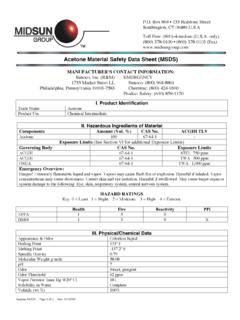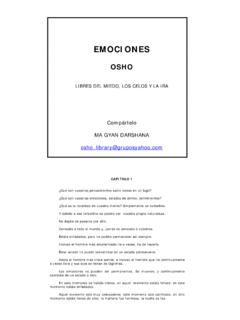Transcription of SECTION 1:Chemical Product and Company Identification
1 Material Safety Data Sheet SECTION 1:Chemical Product and Company Identification Manufacturer: Cumberland Swan Date: March 2000. One Swan Drive Smyrna, TN 37167. Product : Isopropyl Alcohol (IPA). 50%, 70%, 91% and 99% IPA. Telephone: (615) 459-8900. 24hr Emergency: (615) 459-8900 ext. 5270. SECTION 2: Composition/Information on Ingredients Name: Isopropanol, IPA, 2-Propanol, Dimethyl Carbinol CAS#: 67-63-0. SECTION 3: Hazards Identification Colorless, volatile liquid with the odor of rubbing alcohol. Isopropyl Alcohol is a dangerous fire risk. Prolonged exposure to elevated concentrations of vapors may result in irritation of the eyes, nose, and throat and central nervous system (CNS) depression.
2 Prolonged dermal exposure can result in dry, cracking skin. Potential Routes of Exposure: Ingestion, inhalation, dermal contact, eye contact Target Organs: Eyes, skin, respiratory system Symptoms of Overexposure: Inhalation: Mild irritation of eyes, nose and throat. Ingestion: Drowsiness, headache Dermal Contact: Dry, cracking skin Acute Effects: Irritation of skin and/or upper respiratory tract as noted above. Acute CNS depression may be manifested as giddiness, headache, dizziness and/or nausea. Chronic Effects: Chronic exposure can result in skin irritation and contact dermititus Pre-existing disorders of the skin, eyes, and respiratory tract may be exacerbated by exposure to isopropyl alcohol.
3 HMIS: H=1, F=3, R=0 See SECTION 8 for PPE information SECTION 4: First Aid Measures Eye: Flush eyes with copious amount of water for at least 15 minutes Skin: Flush with water. If irritation persists, seek medical attention. Ingestion: Do not induce vomiting if victim is unconscious or drowsy. Seek medical attention or contact the poison control center. Inhalation: Remove victim to fresh air and provided oxygen if breathing is difficult. Seek Medical attention if breathing continues to be difficult. Isopropyl Alcohol MSDS Page 1 of 3. SECTION 5: Fire Fighting Measures Extinguishing Media: Use water fog, alcohol foam, dry chemical or CO2. Unusual Fire or Containers exposed to intense heat from fires should be Explosion Hazards: cooled with large amounts of water to prevent buildup of internal pressure due to vapor generation which could result in container rupture.
4 Recommendations: Clear area of unprotected personnel. Wear complete turnout gear. Cool containers exposed to fire with water. SECTION 6: Accidental Release Measures Large Spills: Eliminate all ignition sources. Equipment must be grounded to prevent sparking. Evacuate the area of unprotected personnel. Contain source of spill. Dike or otherwise confine spilled Product . Uncontrolled releases to air, land, or water may be reportable to the National Response Center (1-800-424-8802). Small Spills: Take up with absorbent material and place in non-leaking container; seal tightly. Dispose of absorbent (see SECTION 13). SECTION 7: Handling and Storage Storage Requirements: Store in tightly closed containers in a cool, dry area away from heat and other possible ignition sources.
5 Handling precautions: Use non-sparking tools to open containers. Maintain appropriate class of fire extinguishers nearby in case of fire. SECTION 8: Exposure Controls / Personal Protection OSHA PEL=400ppm OSHA STEL=500ppm IDLH=12,000ppm Recommended Engineering Controls: Use explosion-proof ventilation equipment as necessary to maintain airborne concentrations below the PEL. Ground all containers to prevent static sparks during fluid transfers. Recommended Admin Controls: Train employees on the hazards of Isopropyl Alcohol PPE: Goggles, gloves, NIOSH approved respiratory protection required when above PEL/TWA. Recommended Hygiene Practices: Clean PPE and work clothing contaminated prior to reuse.
6 After working with this Product , be sure to wash before eating, smoking, drinking, or applying cosmetics. SECTION 9: Physical and chemical Properties Appearance: Colorless Liquid UEL: 12% LEL: 2%. Odor: Mild Rubbing Alcohol Odor Threshold: 43ppm Water solubility: Miscible 50% IPA 70%IPA 91%IPA 99%IPA. Vapor Pressure (@ 680F) approx. 29mm 23mm 33mm 33mm Specific Gravity .929 .878 .790 .790. Boiling Point 176 0 F 176 0 F 180 0 F 181 0 F. Flash Point (TAG Open Cup) 0 F 0 F 54 0 F 53 0 F. - Freezing Point 32- 50 C 32- 50 C 32- 50 C -127 0 F. - 0 - - 0 - - 0. Molecular Weight Auto Ignition Temperature No Data No Data No Data 750 0 F. Isopropyl Alcohol MSDS Page 2 of 3. SECTION 10: Stability and Reactivity Stability: Stable Polymerization: Will not occur Incompatible Chem: Strong oxidizers, acetaldehyde, chlorine, ethylene oxide, acids, isocyanates Conditions to avoid: Heat, sparks, and open flame.
7 Do Not store in aluminum > 120 0 F. Hazardous Products: CO and unidentified organic compounds may be formed of Decomposition SECTION 11: Toxicological Information LD50: 5,840 mg/kg (acute oral - rat); 13,000 mg/kg (acute dermal - rabbit). LD50: 16,000 ppm/8hr (inhalation - rat) Mutagenicity: Not Indicated LDlo : 5,000 mg/kg (oral - rabbit) Reproductive Effects: Not Indicated Carcinogenicity: Not identified as a carcinogen by OSHO, IARC, or NTP. SECTION 12: Ecological Information Ecotoxicity: N/A Environmental Fate: N/A. Soil Absorption/Mobility: Highly Mobile Environmental Degradation: Should be removed readily from soils and water by volatilization and biodegradation. SECTION 13: Disposal Considerations Disposal: Contact your supplier or a licensed contractor for detailed recommendations.
8 Disposal regulatory Requirements: Follow applicable Federal, state, and local regulations. Consider fuels blending as an alternative to incineration. SECTION 14: Transport Information DOT Shipping Name: Isopropanol DOT Packing Group: II. DOT Hazard Class: 3 DOT Label: Flammable Liquid UN ID#: UN 1219. SECTION 15: Regulatory Information RCRA Hazardous Waste Number/ Classification:D001 CERCLA Substance: N/A. HAZARDOUS AIR POLUTANT (CAA): No SARA 311/312 Codes: N/A. SARA Toxic chemical : Yes, (Strong manufacturing only). CERCLA Reportable Quantity: 10,000 lbs (Default). SECTION 16: Other Information Prepared by: Cumberland Swan Sources of Information: 29 ; NIOSH Pocket Guide to chemical Hazards (1993); Occupational Health Guidelines for chemical Hazards; NFPA Guide to Hazardous Materials - 10th Edition.
9 Disclaimer: While reasonable care has been taken to ensure the accuracy and completeness of the information regarding the material described herein, it is the purchaser's responsibility to ensure the suitability of such information as it applies to the purchaser's intended use of the material. Isopropyl Alcohol MSDS Page 3 of 3.









